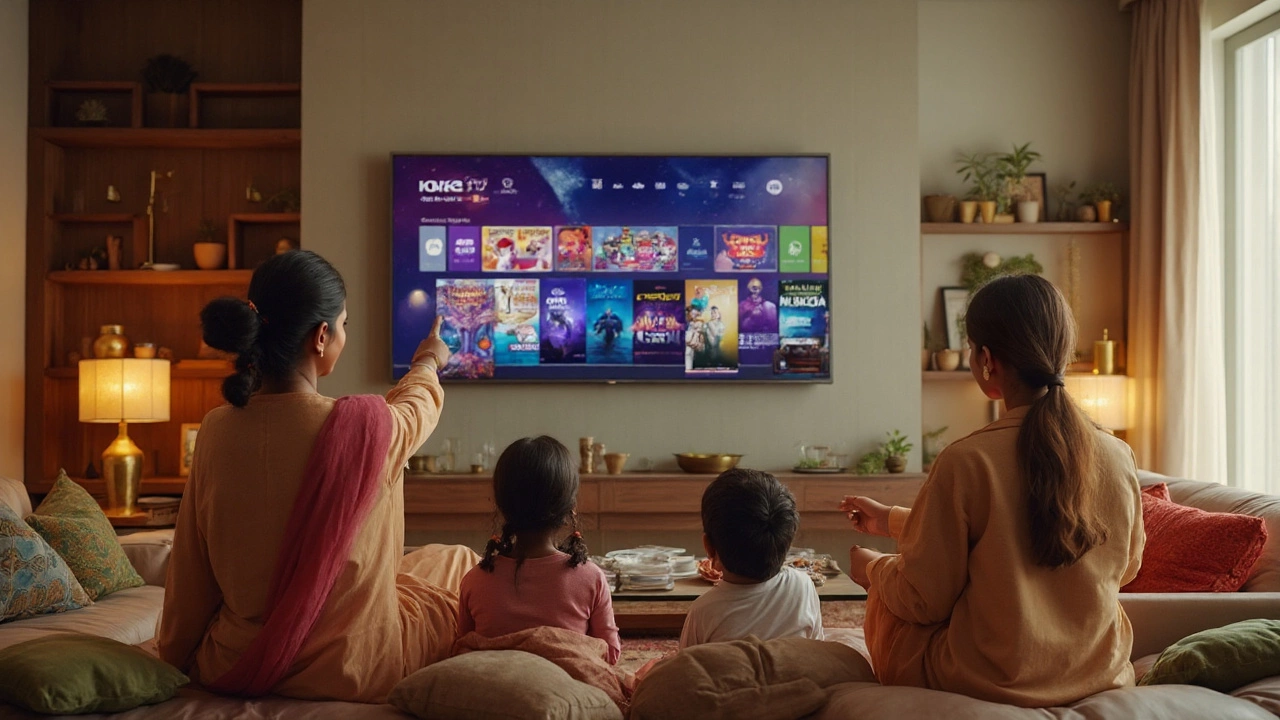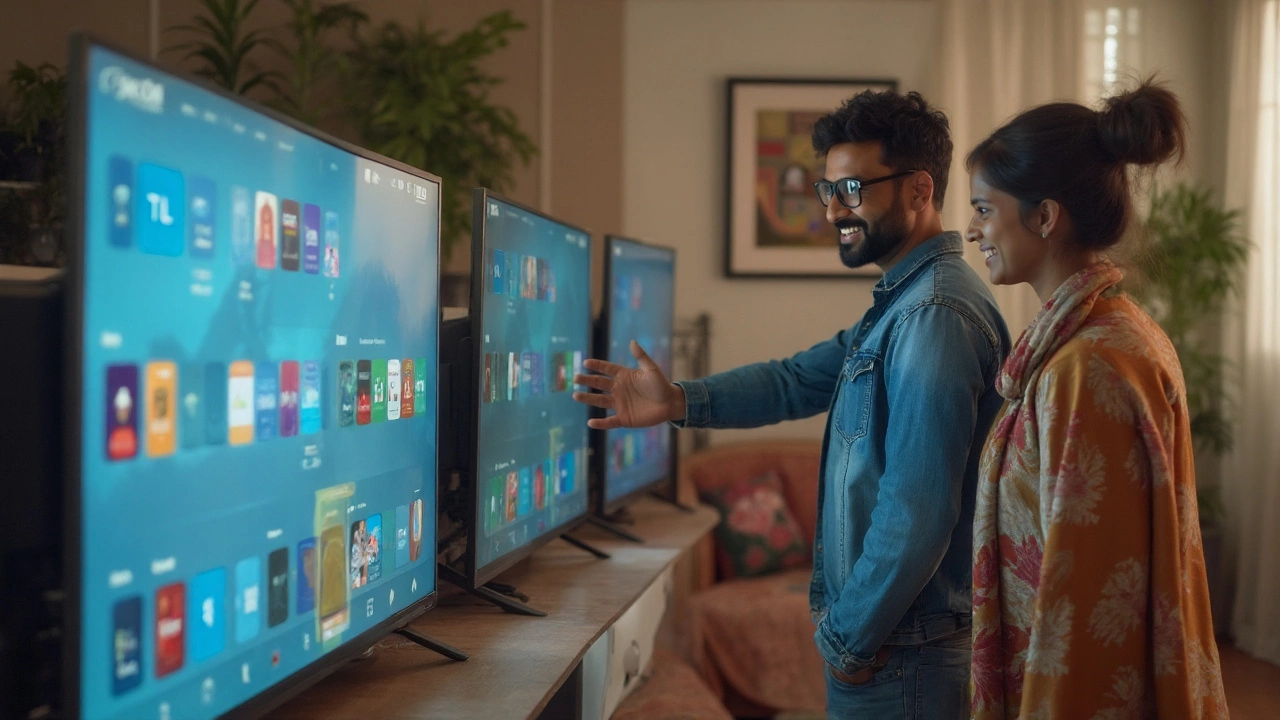
The term 'TV night' doesn’t mean what it used to. People now want a massive, razor-sharp screen that hooks instantly to Netflix, skips lag, and looks just as good off as it does on. Price tags for new tellies can leap up like an auction at Sotheby’s, and everyone’s got a pitch: ‘Better colors! Faster refresh! Immersive sound!’ But blink, and you’ll miss an update. So, which brand actually rules the TV scene in 2025? You’ll be surprised—it’s not just about the name on the box.
How TV Brands Battle for the Top Spot
Every big TV maker wants you to think they’ve got the secret sauce. Start with Samsung. They’ve topped global sales for years, rolling out QLED panels that glow bright even in a sun-filled lounge, and their designs have gotten so thin they almost disappear. Their 2025 flagship, the QN90D, brings in the Neo QLED Mini LED tech. You get wild contrast and buttery motion. Gamers especially rave about the 4K 144Hz refresh rate—no ghost trails, even when you’re chasing down zombies in the dark.
Then there’s LG. For anyone obsessed with black levels, it’s hard to beat their OLEDs. The LG G4 dropped jaws this year thanks to their OLED evo Panel with MLA tech, pumping up both brightness and longevity. You get a picture that pops, but none of the hazard with burn-in that used to scare users. Smart webOS works with voice, and setups now take only a few taps. The G4 even won the What Hi-Fi 2025 Best TV award for its visuals and handling of upscaling older stuff to look crisp.
Don’t count out Sony, either. Their Bravia XR A95L topped several reviewers’ lists with that QD-OLED panel. Sony’s secret is their Cognitive Processor XR, which seems to guess what viewers want and tweaks contrast and color in real time. It’s like an AI inside that knows how you want things to look, and it pays off with sports or movies—faces stay natural, motion flows smooth.
Chinese giants like TCL and Hisense are putting up a fight, too. They keep undercutting prices but stack in features you used to only see on flagship sets. TCL’s QM8 Mini-LED is the wild card—it’s far cheaper than most Samsung or Sony choices but delivers local dimming, HDR support, and robust brightness. Hisense's U8N, with their ULED tech, now rivals budget models from the old guards without looking like a compromise. Over in the UK, these options gobbled up market share as inflation bit deeper.
Let’s toss in a quick data table, just to see how things stacked up in 2025’s first half:
| Brand | Flagship Model (2025) | Panel Tech | Peak Brightness (nits) | Global Units Sold (millions) | Avg. UK Price (£, 65”) |
|---|---|---|---|---|---|
| Samsung | QN90D | Neo QLED Mini LED | 2600 | 45 | 2100 |
| LG | G4 OLED | OLED evo (MLA) | 1500 | 32 | 2299 |
| Sony | Bravia XR A95L | QD-OLED | 1350 | 19 | 2599 |
| TCL | QM8 | Mini-LED | 2100 | 24 | 1399 |
| Hisense | U8N | ULED Mini-LED | 1900 | 15 | 1049 |
Watch any football match at a mate’s house and you’ll see, picture quality isn’t just a number game. It’s all about how the panel copes with glare, deals with color splashes, and stays cool in summer heat. Brands fight dirty for the top, but only a few consistently deliver in all areas that matter—brightness, reliability, future-proofing, and value.
What Makes a TV Brand “Number 1”?
It’s easy to fall for marketing, but being the ‘number 1’ TV brand is about much more than flashy commercials or a slick remote. Longevity counts. A real king-of-the-hill TV set should keep going strong for at least 7–10 years. Samsung has held the sales crown since 2006—seriously, nearly two decades. But that doesn’t mean their sets are always the best for every situation.
Let’s break it down. You want: consistent performance, realistic color, solid sound (without having to rig up a Dolby Atmos system), and smart features that won’t just die in a year or two. Samsung’s Tizen OS keeps updates rolling and has fewer app crashes than older rivals. Users report their phones link up easily, screen mirroring just works, and the new Gaming Hub is huge for PS5 and Xbox Series X players. LG, on the other hand, makes life easy for anyone in the Apple world. AirPlay is seamless, and the Magic Remote is way better than poking around tiny arrows. LG also pushes updates for webOS longer than most, making their TVs far less likely to turn dumb before you’re ready to replace them.
Sony plays heavily on image processing. Their niche? Movie lovers, sports junkies, and anyone who hates soap opera effect. With that Cognitive Processor XR, faces stay natural and motion is smooth. Their Google TV interface is super flexible—add any app without any headaches. If you’re OK spending extra, Sony often looks better, especially in dim rooms with tricky lighting.
Let’s not skip the budget warriors. TCL and Hisense may lag on premium features, but they sell reliable 4K panels that still support Dolby Vision HDR, 120Hz gaming, and snappy smart platforms. TCL’s Roku-based panels and Hisense’s Vidaa boast the lowest failure rates among entry-level sets surveyed by Which? in 2025. And here’s a tip: More people in the UK chose TCL in the sub-£1,500 range last year than ever before.
So, what actually makes a brand number 1? It’s all about consistency, innovation, and being ahead on the right features, not just hype.

Real-World Tests: What Users Really Care About
Step into any family’s living room and you’ll hear: ‘Who’s got the remote?’ But after a week with your new TV, other questions show up. Can it handle peak brightness for sunny mornings? Does Freeview work without freezing? Will it play nice with the PS5 or Xbox, input lag-free? Here’s the skinny from everyday users and trusted sources.
Samsung owners consistently mention killer brightness—no glare, even with the English sun crashing in. The QN90D spanks the competition for glare control, which matters when your sofa faces a window. Plus, Samsung’s One Connect box lets you stuff messy cables out of sight. Not showy, but if you hate clutter, you’ll fall in love. LG G4 owners rave about the infinite contrast, especially for dark movies (think Stranger Things or Oppenheimer). Even in pitch black rooms, you spot every detail. And LG’s quick start times mean no waiting around—hit the remote, and the panel is on, fast.
Sony’s Bravia A95L is king for upscaling old DVDs or shaky streams. Football looks like it’s shot for 2025, even when you’re actually watching old match reruns. People love that the TV doesn’t force the fake ‘smooth’ look—important for films, not just sport. TCL and Hisense don’t just get points for price. Their new models almost match higher-end sets for backlight dimming and HDR punch, at a fraction of the cost. Hisense’s U8N was rated the best value 75” UK TV by T3 magazine, thanks to the panel keeping pace with much pricier tech.
If you’ve got a houseful of gadgets, you’ll appreciate TVs that play nice with everything. Samsung and LG both offer screen sharing, tap-to-cast, and their own take on ‘SmartThings’ hubs. Voice controls? You get Alexa and Google as standard, plus Bixby on Samsung if you want to give it a try. LG’s been making strides supporting smart home kit, so you control your lights and doorbell from the same remote.
A fun fact: The most searched TV feature in the UK in spring 2025 has been ‘HDMI 2.1 support’. Why? Because people want buttery-smooth 4K120Hz gaming. Only Samsung, LG, and Sony’s flagships nail this perfectly, but TCL and Hisense have jumped in on select models too.
Tips for Picking Your 2025 TV Like a Pro
If you’re ready to part with hard-earned cash, don’t grab the first discount that pops up on Amazon Prime Day. A few quick tips makes sure you get a set you’ll love for years. First, check the panel type—OLED wins on cinema nights, but QLED or Mini-LED are better for bright rooms and gaming marathons. If your space gets daylight most hours, look for a TV with high peak brightness (over 1500 nits is ideal).
Gamers should grab TVs with genuine HDMI 2.1 support—not just labeled, but delivering real 4K120Hz with VRR and ALLM. Both Samsung QN90D and LG G4 shine here. Movie buffs: Look for Dolby Vision and HDR10+—the more formats, the better. Sony’s A95L is a beast for this, but you’ll pay for bleeding-edge performance. For families or frequent binge-watching, pick a TV known for low failure rates and reliable support—this is where brands like LG and Samsung edge ahead by keeping parts and software upgrades coming for longer.
Always check the remote! LG’s Magic Remote offers tonnes of functions with a single click. Samsung’s SolarCell remote is handy—never buy AAA batteries again. And if you’re heavy into smart assistant life, get a set with built-in Alexa or Google Assistant. Want future-proofing? Pick a TV with at least four HDMI ports, fast Wi-Fi 6E, and robust firmware update commitments (read recent user reviews).
- Consider the room size. A 65-inch is usually perfect for most UK lounges. Bigger is not always better, unless you sit far back.
- Test sound before buying. Integrated speakers on flagships like Sony’s A95L can actually rival soundbars now.
- Try to see demo units in-store. Motion, colors, and upscaling often look better (or worse) in person than specs suggest.
- Don’t torture yourself with super cheap brands—warranty claims suck up your time, and picture drop-offs are common after a year.
- If you’re keen on new tech, watch for microLED. It’s still pricey, but some limited Samsung models in 2025 finally hit the UK.
So, which TV is truly number 1? If you want the *best TV brand*, Samsung still holds the crown in 2025 for all-round performance, sales, and feature set. LG remains top for home cinema nuts, Sony’s for artful movie fans, and TCL/Hisense for rock-bottom price fighters. Match your budget and room to the right brand, and you’ll never regret the binge you’re about to have.